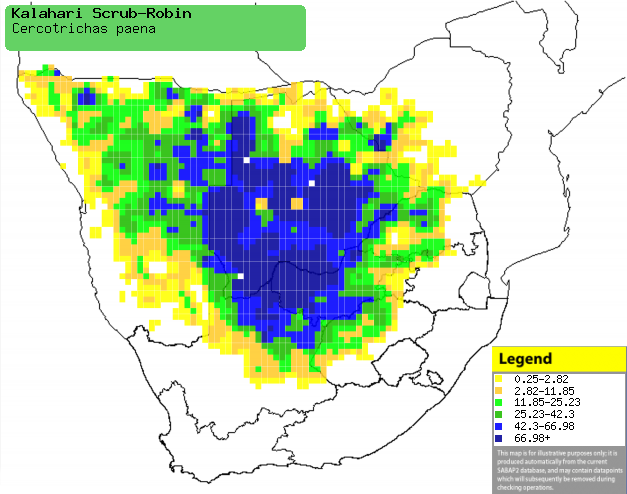|
Cercotrichas paena (Kalahari
scrub-robin)
[= Erythropygia paena]
Kalahariwipstert [Afrikaans];
Phênê [Tswana]; Kalahari-waaierstaart [Dutch]; Agrobate du Kalahari
[French]; Kalahariheckensänger [German]; Rouxinol-do-mato do Kalahari
[Portuguese]
Life
> Eukaryotes >
Opisthokonta
> Metazoa (animals) >
Bilateria >
Deuterostomia > Chordata >
Craniata > Vertebrata (vertebrates) > Gnathostomata (jawed
vertebrates) > Teleostomi (teleost fish) > Osteichthyes (bony fish) > Class:
Sarcopterygii (lobe-finned
fish) > Stegocephalia (terrestrial
vertebrates) > Tetrapoda
(four-legged vertebrates) > Reptiliomorpha > Amniota >
Reptilia (reptiles) >
Romeriida > Diapsida > Archosauromorpha > Archosauria >
Dinosauria
(dinosaurs) > Saurischia > Theropoda (bipedal predatory dinosaurs) >
Coelurosauria > Maniraptora > Aves
(birds) >
Order: Passeriformes > Family: Muscicapidae
> Genus: Cercotrichas
Distribution and habitat
Near-endemic to southern Africa, occurring from South-West
Angola through Namibia to Botswana, north-central South Africa and Zimbabwe. It
generally prefers arid and semi-arid habitats with scattered trees, bushes and
patches of bare ground, such as sandveld, scrub and wooded savanna; it is also a
regular in the gardens and yards of farm homesteads.
|
 |
|
Distribution of Kalahari scrub-robin in southern Africa,
based on statistical smoothing of the records from first SA Bird Atlas
Project (©
Animal Demography unit, University of
Cape Town; smoothing by Birgit Erni and Francesca Little). Colours range
from dark blue (most common) through to yellow (least common).
See here for the latest distribution
from the SABAP2. |
Brood parasites
It has been recorded as host of the
Diderick
cuckoo.
Food
It mainly eats insects, especially ants, beetles and
termites, doing most of its of its foraging on bare ground. The following food items have been recorded
in its diet:
Breeding
- The nest is a compact cup set into a messy structure of dry grass, leaves
and occasionally twigs, the interior lined with finer material such as
tendrils, rootlets and animal hair. It is typically placed close to, but not
on the ground in a shrub, or occasionally in a man-made objects such as a
tin.
- In moister regions egg-laying season is from July-January, peaking
during October, but in more arid areas it can breed at any time of year in
response to rainfall.
- It lays 2-4 eggs, which are incubated solely by the female for 13 days.
- In one observation the chicks stayed in the nest for about 14 days.
Threats
Not threatened.
References
-
Hockey PAR, Dean WRJ and Ryan PG 2005. Roberts
- Birds of southern Africa, VIIth ed. The Trustees of the John Voelcker
Bird Book Fund, Cape Town.
|
